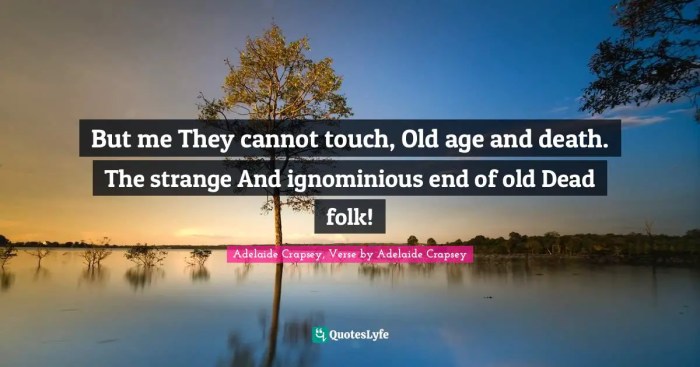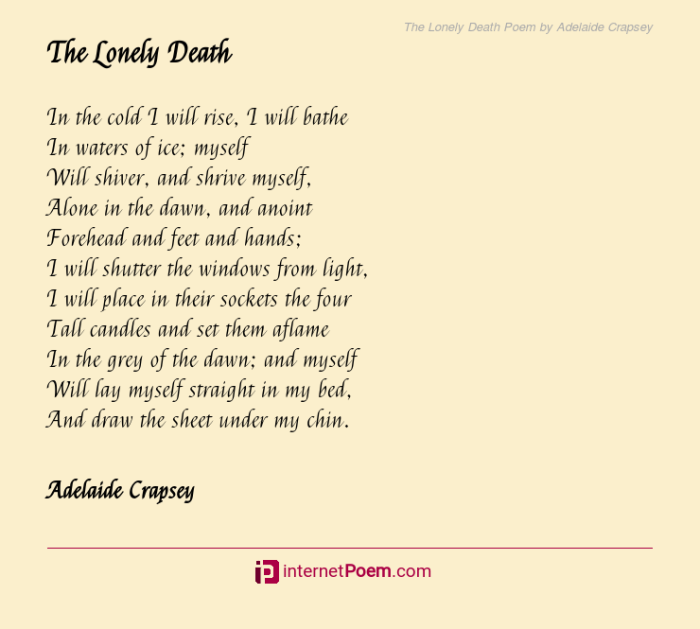How does Crapsey plan to face death? This question lies at the heart of Adelaide Crapsey’s poignant and insightful poetry, which grapples with the inevitability of mortality and the search for meaning in its face.
Crapsey’s unique perspective on death, shaped by her personal experiences and literary influences, finds expression in her innovative use of form and language, leaving a lasting legacy in the literary world.
Overview of Adelaide Crapsey’s Life and Literary Influences

Adelaide Crapsey (1878-1914) was an American poet and critic who made significant contributions to the literary movement of Imagism. Her work was influenced by the principles of Symbolism and Imagism, which emphasized the use of vivid imagery, precise language, and a focus on the sensory experience.
Early Life and Education
Crapsey was born in Rochester, New York, in 1878. She attended Vassar College, where she studied English literature and philosophy. During her time at Vassar, she came under the influence of the poet Harriet Monroe, who encouraged her to pursue her writing.
Literary Influences
Crapsey’s literary influences include the Symbolist poets, such as Stéphane Mallarmé and Paul Verlaine, who emphasized the use of evocative language and imagery to suggest deeper meanings. She was also influenced by the Imagist poets, such as Ezra Pound and H.D.
(Hilda Doolittle), who advocated for a concise, precise, and image-driven poetry.
Major Life Events
In 1901, Crapsey graduated from Vassar College and moved to New York City, where she worked as a teacher and critic. In 1907, she published her first collection of poems, “Verse,” which was well-received by critics. In 1914, Crapsey died of tuberculosis at the age of 36.
Crapsey’s Unique Poetic Form and Style

Adelaide Crapsey’s poetry stands out for its innovative form and distinctive style. Her use of the cinquain form, a five-line poem with a specific syllable count pattern, sets her work apart from her contemporaries.
Cinquain Form, How does crapsey plan to face death
The cinquain form, introduced by Crapsey, consists of five lines with the following syllable count pattern:
- Line 1: 2 syllables
- Line 2: 4 syllables
- Line 3: 6 syllables
- Line 4: 8 syllables
- Line 5: 2 syllables
This structure creates a concise and lyrical form that allows Crapsey to explore themes and emotions with precision and impact.
Distinctive Features
Beyond the cinquain form, Crapsey’s poetry is characterized by its:
- Precise imagery:She uses vivid and evocative language to create sharp and memorable images.
- Concise language:Her poems are often brief and to the point, with each word carefully chosen for its impact.
- Musicality:Crapsey’s poems have a strong musicality, with a focus on rhythm, rhyme, and sound patterns.
Themes and Motifs
Crapsey’s poetry explores a range of themes, including:
- Nature and the seasons
- Love and loss
- Beauty and transience
- The search for meaning and purpose
Her work is often marked by a sense of melancholy and reflection, as she contemplates the passage of time and the inevitability of death.
Crapsey’s Perspective on Death and Mortality

Adelaide Crapsey’s life was marked by both personal experiences with illness and death and a profound poetic exploration of mortality. Her own declining health, coupled with the loss of loved ones, shaped her unique perspective on the inevitability of death.
Personal Experiences with Illness and Death
Crapsey’s personal struggles with tuberculosis significantly influenced her perception of death. Diagnosed in 1905, she spent the remaining years of her life battling the disease. The physical and emotional toll it took on her fueled her poetic reflections on the fragility of life and the inevitability of death.
Influence on Poetic Exploration
Crapsey’s personal experiences with mortality led her to confront death in her poetry with both fear and acceptance. Her poems often oscillate between moments of despair and resignation to the natural order of things. She explored the themes of mortality, loss, and grief with unflinching honesty and a lyrical intensity that transcends the boundaries of personal experience.
Depictions of Death in Poetry
Crapsey depicted death in her poems in various ways. Sometimes, she personified death as a figure of fear and sorrow, evoking its chilling presence and the anguish it brings. At other times, she embraced death as a natural part of the human experience, finding solace in its inevitability and the promise of transcendence beyond the physical realm.
Crapsey’s Legacy and Influence

Adelaide Crapsey’s work received critical acclaim during her lifetime and continues to be celebrated by literary critics and scholars today. Her unique poetic form, the cinquain, has become synonymous with her name and has influenced countless subsequent poets.
Reception and Critical Acclaim
Crapsey’s first collection of poems, Verse(1893), was met with mixed reviews. However, her second collection, The Last Day(1912), was highly praised by critics for its originality and emotional depth. In the years since her death, Crapsey’s work has been anthologized and studied extensively.
Impact on Subsequent Generations of Poets
Crapsey’s poetry has had a profound impact on subsequent generations of poets. Her use of the cinquain form has inspired countless other poets to experiment with new and innovative forms. Her themes of death, mortality, and the human condition have also resonated with poets such as e.e.
cummings, Marianne Moore, and Elizabeth Bishop.
Enduring Relevance and Significance
Crapsey’s themes and poetic style continue to be relevant and significant in contemporary literature. Her exploration of death and mortality remains a timeless subject, and her unique poetic form provides a fresh and innovative way to express complex emotions. Crapsey’s work serves as a reminder of the power of poetry to capture the human experience and to transcend the boundaries of time and place.
FAQ Explained: How Does Crapsey Plan To Face Death
What influenced Crapsey’s poetic style?
Crapsey was influenced by the literary movements of Symbolism and Imagism, which emphasized the use of evocative imagery and concise language.
How did Crapsey’s personal experiences shape her perspective on death?
Crapsey’s own struggles with illness and the loss of loved ones deeply influenced her understanding of mortality and the human condition.
What is the significance of the cinquain form in Crapsey’s poetry?
Crapsey’s innovative use of the cinquain form, a five-line poem with a specific syllable count, allowed her to explore complex themes with precision and economy.
